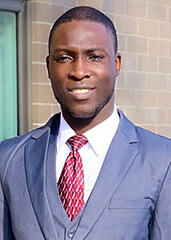 Taiwo Ehineni, Preceptor of African Languages, emphasizes the importance of “cultural frames” in language learning, or the ecologies in which the language is developed and used. “When students come to take my language class, it is an opportunity to introduce them to Nigeria.” One way this is accomplished is by using songs and music, which express culturally resonant ideas through creative uses of language. Ehineni teaches Yoruba as well as West African Pidgin. Class begins with students singing a song in Yoruba together while Ehineni plays the drums. Then they generate a vocabulary list based on the song they sang together, examine the grammatical use of the word in the lyrics, and look up the meaning.
Taiwo Ehineni, Preceptor of African Languages, emphasizes the importance of “cultural frames” in language learning, or the ecologies in which the language is developed and used. “When students come to take my language class, it is an opportunity to introduce them to Nigeria.” One way this is accomplished is by using songs and music, which express culturally resonant ideas through creative uses of language. Ehineni teaches Yoruba as well as West African Pidgin. Class begins with students singing a song in Yoruba together while Ehineni plays the drums. Then they generate a vocabulary list based on the song they sang together, examine the grammatical use of the word in the lyrics, and look up the meaning.
Developing cultural and linguistic competencies through music
The benefits
Singing together helps students become more confident in their linguistic abilities, particularly in the tonal complexities of Yoruba. But more deeply, it sets a jovial, community-driven atmosphere for the rest of class and better facilitates students’ proficiency in Yoruba as well as their understanding of how Yoruba is used for meaning-making in Nigerian contexts. “When students come to my class, they’re not just learning the language,” Ehineni explains. “They’re learning about the community. They’re not just becoming linguistically proficient. They’re becoming culturally competent.”
“When students come to take my class, they’re not just learning the language. They’re learning about the community. They’re not just becoming linguistically proficient. They’re becoming culturally competent.”
The challenges
“The only challenge is what song?” Ehineni explains. Picking content that matches whatever theme they are learning can be difficult—in part because there are so many to choose from, and in part because old songs can bring new meaning as students become more proficient. Ehineni as a result takes great care in selecting and scaffolding music for students based on the content they’re examining that week.
Takeaways and best practices
-
The opening sets the tone for the rest of class.
Ehineni underscores the importance of setting the tone at the beginning of class for the learning conducted. Singing Yoruba songs are a great way to remind students, as Ehineni notes, “when they are in my class, they’re not in Harvard. They’re in Nigeria.” It also lifts the mood of the course to get students engaged in understanding the language for the rest of the session. -
Create spaces for collective, community work in class.
Sometimes students have anxiety about how they sound personally or what they will say if put on the spot individually. Ehineni makes everyone feel confident and meets them where they are at through collective singing. No one person is leading, and everyone is participating in making music as a collective effort. This helps everyone feel engaged and supported as learners in his classroom. -
Engage students in the culture.
Ehineni notes that at times speakers of certain languages might be the only speakers of that language the student has met. As a result, it is essential to recognize that, as he describes, “the language class is a speech community but also a cultural community.” Ensuring students “perform” the language is essential for them to be able to better understand “the experience of the native speaker."
Bottom line
Ehineni emphasizes that fusing cultural ecologies and linguistic understanding is essential for students’ ability to understand what to do with language. As a result, he structures his classroom carefully so that every aspect—from the songs selected for their collective singing to drumming and dancing—all support students in the communal work of language learning. “With that kind of confidence built in,” Ehineni describes, “anything is possible.”
